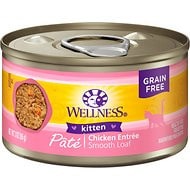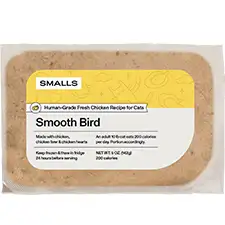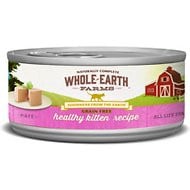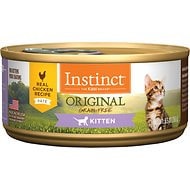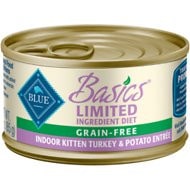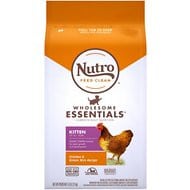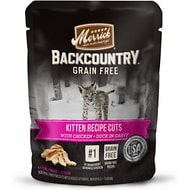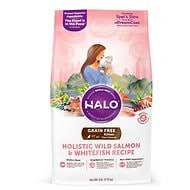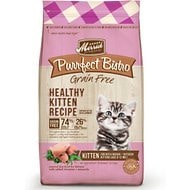Contents
- What Is The Best Cat Food For Nursing Mothers?
- What You Need to Know About Pregnancy in Cats
- Nutritional Needs for Pregnant Cats
- What to Look for in a Good Cat Food for Nursing Mothers
- How Do We Make Our Recommendations?
- The 10 Best Cat Foods for Nursing Mothers
- 5 More Top-Rated Cat Foods for Nursing Mothers
- Castor & Pollux Organix Grain-Free Organic Kitten Recipe Canned Food
- Nutro Wholesome Essentials Chicken & Brown Rice Recipe Kitten Food
- Merrick Backcountry Grain-Free Kitten Recipe Cuts Cat Food Pouches
- Halo Holistic Wild Salmon & Whitefish Recipe Grain-Free Kitten Dry Food
- Merrick Purrfect Bistro Grain-Free Healthy Kitten Recipe Dry Food
- Frequently Asked Questions
Having one kitten is great but having a whole litter of them is better! At least, that’s what many cat owners think. The reality is that caring for kittens is a big undertaking and before you even get to the kittens, you need to care for your pregnant cat.
Pregnancy in cats is very different from human pregnancy. The gestation period is much shorter – it only lasts about 65 days, on average. During that time, you need to make sure your cat is getting the calories and nutrients she needs to help the kittens develop properly. The work doesn’t stop after the kittens are born, either. At that point you need to feed your cat enough to meet her own nutritional needs while also supporting her milk production for the entire litter.
Breeding your cat isn’t something you should do on a whim. If your cat is already pregnant, however, you should start paying attention to what you’re feeding her sooner rather than later. In this article, we’ll explore the subject of pregnancy in cats. You’ll learn more about the kitten growth cycle and the nutritional needs of nursing mother cats. You’ll also see our top picks for the best cat food for nursing mother cats.
What Is The Best Cat Food For Nursing Mothers?
- Smalls Human-Grade Fresh Cat Food Delivery
- Wellness Complete Health Kitten Formula
- Whole Earth Farms Grain-Free Real Healthy
- Instinct by Nature’s Variety Kitten Grain-Free
- Blue Buffalo Basics LID Grain-Free Indoor Kitten
- Castor & Pollux Organix Grain-Free Organic Kitten
- Nutro Wholesome Essentials Chicken & Brown Rice
- Merrick Backcountry Grain-Free Kitten Recipe
- Halo Holistic Wild Salmon & Whitefish Recipe
- Merrick Purrfect Bistro Grain-Free Healthy Kitten
What You Need to Know About Pregnancy in Cats
You already treat your cat like a princess but when she becomes pregnant, she’s known as a queen. Female cats can become pregnant as young as 4 months and they go into heat every 2 to 3 weeks after that between spring and early fall. No wonder animal shelters are flooded with kittens every summer!
A female cat goes into peak fertility every couple of weeks and at any point during that time, she can become pregnant. The first signs of pregnancy in cats appear around 15 to 18 days after conception. You may notice your cat’s nipples becoming red and enlarged – this is known as “pinking up.” After that, your cat may go through a period of vomiting and then her stomach will start to swell. Be careful about touching your cat’s tummy, though, because you don’t want to risk hurting the unborn kittens.
Some veterinarians are able to detect pregnancy using ultrasound as early as 15 days into the term, but you may not be able to tell how many kittens you should expect until day 40. Larger kittens can obscure smaller kittens in the womb, so you won’t know for sure until they are born. Speaking of birth, most cats handle labor just fine on their own but it doesn’t hurt to be nearby just in case.
Here are the signs of impending or active labor to look for:
- Refusing food or acting fidgety, looking for a quiet place to settle down
- Body temperature dropping to around 100°F 12 to 24 hours ahead of labor
- Becoming more vocal and visibly agitated
- Delivery starts with a strong abdominal contraction and vaginal discharge
- Kittens follow the discharge very quickly and, in most cases, easily
Kittens are great, but you need to be responsible as a cat owner and prevent unplanned litters. We recommend having your cat spayed as early as possible, ideally before she goes into heat for the first time. Your veterinarian will be able to tell you when it’s safe to have your cat spayed.
Nutritional Needs for Pregnant Cats
Most female cats gain 2 to 5 pounds during pregnancy, depending on the number of kittens they carry. Queens tend to have a bigger appetite later in the pregnancy which contributes to weight gain. She may also act more maternal, purring more often and seeking extra attention. If you know when your cat mated, you’ll be able to track her due date and monitor her appetite throughout to know when she might need to start eating a little extra.
Here’s what you need to know about your pregnant cat’s nutritional needs:
- High-quality, balanced nutrition is essential to help your cat maintain healthy body weight and for healthy development of the kittens.
- A healthy, well-fed cat will steadily gain weight throughout the course of the pregnancy but shouldn’t gain weight too quickly.
- Highly digestible recipes formulated for kittens, growth, and development are ideal – the best option is a recipe formulated for gestation and lactation.
- Feed your cat small meals multiple times a day to help her maintain adequate calorie and nutrient intake, especially during the third trimester.
It’s important to feed your cat well, but don’t feed her too much. Obesity in pregnant cats can result in small litter sizes and may decrease milk production during lactation as well. If your cat is overweight and you plan to breed her, you should help her lose weight first. Female cats don’t change in their nutritional needs during the heat cycle.
In addition to understanding your queen’s nutritional needs, it helps to know approximately how many kittens to expect. Litter size varies but the average is 4 kittens. Single kittens sometimes fail to initiate birth on their own and some cats rest for extended periods between kittens in larger litters. Most vets can tell around 4 weeks of pregnancy how many kittens to expect by palpating the abdomen or by using ultrasound. After 7 weeks you can check by x-ray.
What to Look for in a Good Cat Food for Nursing Mothers
When it comes to feeding a pregnant cat, the easiest thing to do is feed her kitten food. Kitten food has more protein and calories than adult cat food, making it ideal for supporting your cat’s health and nutrition in addition to that of her growing kittens. You still need to make sure the recipe is made with healthy, natural ingredients and is complete and balanced, but knowing that you’re looking for kitten food is a good place to start.
Here are some general things to look for in a good cat food for pregnant cats:
- Rich in high-quality animal protein. Protein is the foundation of any healthy diet for cats and becomes increasingly important for pregnant and nursing cats. Kittens and nursing mothers need a minimum of 30% crude protein in their diets, though more is usually better as long as it comes primarily from animal-based sources.
- Very energy dense. After delivery, most pregnant cats lose 40% of the body weight they gained during pregnancy and the rest will be lost during lactation. To support your cat’s energy requirements during pregnancy and nursing, look for an energy-dense recipe. High calorie content is required to meet your cat’s energy requirements to support lactation without her having to eat an obscene amount of food.
- Highly digestible natural ingredients. Whole food ingredients are the most nutritious and biologically valuable for your cat so look for real animal proteins, whole grains, and fresh fruits and vegetables. Fillers and by-products are more difficult to digest and don’t provide the same quality of nutrition.
- Complete and balanced. The nutrition your nursing mother cat receives will be passed along to her kittens, so it’s more important now than ever that she gets balanced nutrition. Vitamin and mineral supplements will help balance out the nutritional content of your cat’s food.
- Higher moisture content. Cats need water just as much as any animal, but nursing mothers need even more because their milk is made up of over 70% water. Choosing a fresh or canned food for your nursing cat is a great option, or you can add a wet food topper to kibble.
Caring for a pregnant cat is not easy. Between keeping your cat comfortable while she’s pregnant and meeting her nutritional needs through a healthy diet, you’ll have your hands full. Read on to see our top picks for the best cat food for nursing mothers but first, see how we make our recommendations.
How Do We Make Our Recommendations?
Whether your cat is pregnant or not, she deserves the best quality diet you can feed her. Cats are obligate carnivores which means that they have high needs for protein in their diets. Protein is best from animal sources like meat, poultry, and fish because it contains all of the essential amino acids your cat needs and it is more biologically valuable than plant proteins. When evaluating pet foods, we consider your cat’s basic nutritional needs and how well they are met with each product. We look at the quality of the ingredients as well as their quantities and compare them to the basic nutritional needs for cats. Rest assured that we’d never recommend anything we wouldn’t be confident feeding our own cats.
Here are some of the general requirements for a cat food to receive our recommendation:
- A source of high-quality animal protein as the first ingredient
- At least 30% crude protein for kittens and at least 26% for adults
- A minimum of 9% crude fat for kittens and adults
- A balance of omega-3 and omega-6 fatty acids, primarily from animal sources
- A rich blend of nutrients from natural sources and supplements, as needed
- Limited carbohydrate content from digestible sources (like whole grains and veggies)
- No low-quality fillers, by-products, or artificial additives (preservatives, dyes, or flavors)
When reviewing cat food, the first thing we do is compare it to AAFCO food nutrient profiles. These profiles simply outline the minimum nutritional needs of cats in various life stages (kitten or adult). If a cat food meets these requirements, it will carry an AAFCO statement of nutritional adequacy on the package. It should look something like this: [X Product] is formulated to meet the nutritional levels established by the AAFCO Cat Food Nutrient Profiles for all life stages. After you have successfully determined that the formula is complete and balanced, you can go on to evaluating its quality.
The 10 Best Cat Foods for Nursing Mothers
One of your biggest responsibilities as a pet parent is choosing a pet food. Pregnant and nursing cats have unique nutrient and energy requirements, so don’t take this decision lightly! We know it’s tough to sort through all of the different cat foods out there which is why we’ve taken it upon ourselves to help you out. Here are some of the best options on the market worthy of your consideration:
| Our 2024 Picks: Best Cat Foods for Nursing Mothers | |||
Smalls Fresh Bird Human-Grade Cat Food
|
CHECK PRICE | ||
Wellness Complete Health Kitten Formula
|
CHECK PRICE | ||
Whole Earth Farms Grain-Free
|
CHECK PRICE | ||
Instinct by Nature’s Variety Kitten Grain-Free
|
CHECK PRICE | ||
Blue Buffalo Basics LID Grain-Free
|
CHECK PRICE | ||
Castor & Pollux Organix Grain-Free
|
CHECK PRICE | ||
Nutro Wholesome Essentials Chicken & Brown
|
CHECK PRICE | ||
Merrick Backcountry Grain-Free
|
CHECK PRICE | ||
Halo Holistic Wild Salmon & Whitefish Recipe
|
CHECK PRICE | ||
Merrick Purrfect Bistro Grain-Free
|
CHECK PRICE | ||
Smalls Fresh Cat Food Delivery
Overall Best Cat Food for Nursing Mothers: When it comes to quality nutrition for your pregnant or lactating cat, it’s hard to do better than fresh food. Fresh food preserves more of the nutritional integrity than dry food cooked at high temperatures and it is often prepared in small batches. When it comes to fresh food, we love Smalls because it delivers premium quality nutrition right to your door. All of Smalls’ recipes feature real animal protein and other natural ingredients to deliver complete and balanced nutrition with more moisture and nutritional value than traditional dry foods. Plus, you can customize your cat’s diet according to her unique calorie needs and receive pre-portioned packages that you simply open and pour into the bowl.
- Pros: Fresh food delivered to your door, real animal proteins, rich in moisture and natural nutrients, prepared in small batches, pre-portioned according to calorie needs
- Cons: Only two recipes to choose from, significantly more expensive than traditional kibble
Wellness Complete Health Kitten Formula Grain-Free Canned Food Recipe
Most Popular Cat Food for Nursing Mothers: If you’re not sure what to feed your nursing mother cat, you can always go with a popular brand like Wellness. The Wellness Complete Health line of cat foods includes wholesome, nutritionally balanced recipes like this kitten food formula. It features real chicken and chicken liver as protein-rich sources of quality nutrition with carrots and cranberries for antioxidants, vitamins, and minerals. This recipe contains plenty of moisture to support lactation and is high in calories at 97 calories per 3-ounce can. This recipe provides a healthy blend of omega-3 and omega-6 fatty acids with chelated minerals to ensure optimal nutrient absorption. Overall, it’s a great option for any nursing mother cat.
- Pros: Real chicken and chicken liver, rich in protein and moisture, fresh fruits and vegetables, plenty of omega-3 and omega-6 fatty acids, chelated minerals for optimal nutrient absorption
- Cons: Contains some gums and thickeners
Whole Earth Farms Grain-Free Real Healthy Kitten Recipe Canned Food
Most Affordable Cat Food for Nursing Mothers: High-quality cat food can be expensive which is why we love the Whole Earth Farms brand. Whole Earth Farms is an affordable product line in the Merrick Pet Care family, and they offer this healthy kitten recipe canned food. It is positively brimming with real chicken and savory flavor, made from USDA-sourced ingredients to ensure quality, digestibility, and nutrition. This recipe is nutritionally balanced for kittens and mother cats, featuring fresh chicken and chicken liver as the main ingredients. It contains a rich blend of omega-3 and omega-6 fatty acids as well to support healthy brain and eye development. You’ll also find all of the vitamins and minerals your nursing cat needs for balanced nutrition.
- Pros: Real chicken first ingredient, high in animal protein, rich in omega fatty acids for brain and eye development, complete and balanced nutrition, rich in moisture
- Cons: Contains some plant protein (dehydrated alfalfa meal)
Instinct by Nature’s Variety Kitten Grain-Free Chicken Pate
Best Wet Food for Nursing Cat Mothers: Wet food is a great option for nursing mothers because canned food tends to be higher in protein than dry food and it is rich in moisture as well. Our top pick for the best cat food for nursing cat moms is this Instinct by Nature’s Variety Kitten Grain-Free Chicken Pate. This savory, protein-rich recipe features a flavorful blend of chicken, salmon, and beef liver tailored to the high calorie needs of kittens and nursing mothers. It contains a rich blend of omega fatty acids with fresh fruits and vegetables to provide natural sources for key nutrients. This recipe is completely and balanced with the help of vitamins and chelated minerals, formulated to provide a whopping 55% protein and 103 calories per 3-ounce can.
- Pros: Rich in real animal protein, high in calories and moisture, rich in natural flavor, complete and balanced nutrition, fresh fruits and vegetables, highly digestible natural ingredients
- Cons: Not a single source protein recipe
Blue Buffalo Basics LID Grain-Free Indoor Kitten Turkey & Potato Entree
Best Cat Food for Sensitive Stomach for Nursing Mothers: Quality nutrition is especially important when your cat is nursing, so if your cat has a sensitive stomach you need to be very careful what you feed her. This Blue Buffalo Basics LID Grain-Free Indoor Kitten Turkey & Potato Entrée is a great choice because it is made with a limited list of ingredients for sensitive stomachs. It features a single source of animal protein with pumpkin for gentle digestion. Plus, it’s formulated for kittens which makes it rich in protein and calories. This canned food is a rich source of omega-3 and omega-6 fatty acids and it’s packed with antioxidant-rich fruits and veggies with all the vitamins and minerals your nursing cat needs for balanced health. Measured as dry matter, this recipe contains nearly 41% protein and 32% fat with 109 calories per 3-ounce can.
- Pros: Rich in protein and calories, real animal protein, highly digestible natural ingredients, moisture-rich, complete and balanced nutrition, formulated for growth
- Cons: May be higher in fiber than some cats need
5 More Top-Rated Cat Foods for Nursing Mothers
Castor & Pollux Organix Grain-Free Organic Kitten Recipe Canned Food
When it comes to high-quality nutrition for cats, it’s hard to do better than organic ingredients. This organic kitten recipe from Castor & Pollux Organix is a great option because it is loaded with naturally nutritious ingredients. It features organic, free-range chicken as the first ingredient and a rich source of premium animal protein. This recipe contains plenty of omega-3s for healthy brain and eye development, balanced with omega-6s for healthy skin and coat. It is made with real fruits and vegetables as natural sources for key nutrients with vitamin and chelated mineral supplements to ensure complete and balanced nutrition. Overall, it provides a dry matter calculation of nearly 41% protein and 32% fat with 207 calories per 5.5-ounce can.
Nutro Wholesome Essentials Chicken & Brown Rice Recipe Kitten Food
If your cat prefers dry food, consider this Nutro Wholesome Essentials Chicken & Brown Rice kitten food. It features real chicken as the main ingredient, delivering a high-protein source of nutrition and natural flavor. This recipe contains DHA, an important omega-3 fatty acid for healthy growth and development as well as plenty of calcium for strong bones and joints. This recipe contains whole-grain carbohydrates to deliver a nutrient-rich source of energy and dietary fiber as well as essential nutrients. It also contains the necessary vitamin and mineral supplements to ensure complete and balanced nutrition for your nursing mother cat.
Merrick Backcountry Grain-Free Kitten Recipe Cuts Cat Food Pouches
Moisture is important to support lactation in nursing mothers, which is why this Merrick Backcountry Grain-Free Kitten Recipe is such a great choice. It is packed with moisture and real meat flavor made with real chicken as the first ingredient to support muscle growth and development. Made in a savory gravy, this recipe will appeal to even the pickiest of eaters and will ensure that your cat gets the protein and calorie she needs to support lactation. What you’ll really love is that it’s great for use as a food topper but it’s also complete and balanced so you can use it as a staple diet.
Halo Holistic Wild Salmon & Whitefish Recipe Grain-Free Kitten Dry Food
Give your cat the gift of holistic, natural nutrition with this Halo kitten food recipe. It features real, whole salmon and whitefish as primary ingredients and is completely free from rendered meat meals. This recipe offers an ideal balance of vitamins, minerals, and other nutrients to give your cat the nutrition she needs to support growing kittens. This formula is rich in natural sources for key nutrients including non-GMO sweet potatoes, blueberries, and cranberries with no grains, gluten, hormones, or antibiotics. Simply put, it’s a complete and balanced recipe any nursing mother would love.
Merrick Purrfect Bistro Grain-Free Healthy Kitten Recipe Dry Food
Another healthy option in dry food for nursing cats is this Merrick Purrfect Bistro recipe. Packed with 74% protein and fat ingredients, this formula is just what your mother cat needs for healthy energy. This recipe features fresh chicken as the main ingredient with chicken and turkey meals as concentrated sources of supplemental protein. It is grain-free and gluten-free for easy digestibility and has fresh fruits and vegetables like sweet potatoes and peas for nutritional support. This formula is complete and balanced with the help of vitamin and chelated mineral supplements, plus it contains probiotics for healthy and regular digestion.
Frequently Asked Questions
- How much should a nursing cat eat? There is no simple answer to the question how much should a nursing cat eat. Every cat is different based on her size before pregnancy and the number of kittens she’s carrying. Most cats gradually eat more throughout the gestation period, ending at 50% to 100% more than the amount they were eating before they got pregnant. Most cats gain 2 to 5 pounds during pregnancy, though they lose most of the weight after delivery due to the high calorie burn caused by lactation. A nursing cat needs a high-calorie source of balanced nutrition to support lactation, so give your cat as much as she needs to eat.
- How often should I feed my nursing cat? Many cat owners choose to simply keep their cat’s food bowl full during pregnancy so she can self-regulate. There are risks associated with both underfeeding and overfeeding, however, so you should monitor your cat’s food intake either way. Your veterinarian will help you track your cat’s weight to make sure she’s healthy and may recommend a higher calorie formula if she needs to gain a little weight. You should plan to feed your nursing cat several times a day or you can simply give her free access to food so she can eat as much as she needs.
- Do we recommend homemade food for nursing cats? During pregnancy and nursing, your cat needs a high-quality diet to deliver balanced nutrition. She will be burning through more calories than ever during pregnancy and when she is lactating, so it’s important to feed your cat as much food as she needs to support milk production. If you’re worried about the quality of your cat’s diet, you might be considering homemade food. The problem with homemade food for nursing cats is that you may have trouble balancing your cat’s nutrient intake. The only way you should ever feed your cat a homemade diet is if its veterinarian-approved to deliver balanced nutrition. That doesn’t change when your cat is pregnant or nursing.
- How can I help my cat produce milk? The key to milk production is making sure your cat has the calories and nutrients she needs. Malnutrition is a common cause for a mother cat to stop producing milk, so you need to make sure your cat is properly nourished with a high-quality kitten food. Stress can also affect your cat’s lactation, so make sure she isn’t overly stressed. If your cat simply can’t produce enough milk to sustain her litter, you may need to start feeding them by hand.
- Do nursing cats need more food? Generally speaking, nursing cats have higher energy requirements than the average cat but your cat doesn’t need to eat an obscene amount of food. Your cat’s appetite will gradually increase throughout the course of her pregnancy. By the time she delivers, however, she may only be eating 50% more than she was at the beginning. Some cats need more food, however, so you may want to simply keep your cat’s food bowl filled so she can eat as much as she wants.
Your cat is your princess, but she becomes a queen when she gets pregnant. You always want what’s best for her but choosing the best cat food becomes even more important during and after pregnancy. The quality of your cat’s diet can influence the development of her kittens both in the womb and after delivery, so don’t take the task of caring for a pregnant cat lightly!
The key to health and wellness for both your cat and her kittens is a high-quality, nutritious diet. The best place to start looking is a wholesome, natural kitten food like one of the recipes we’ve reviewed above. If you’re not sure what to feed a nursing mother cat, try one of our top picks!

